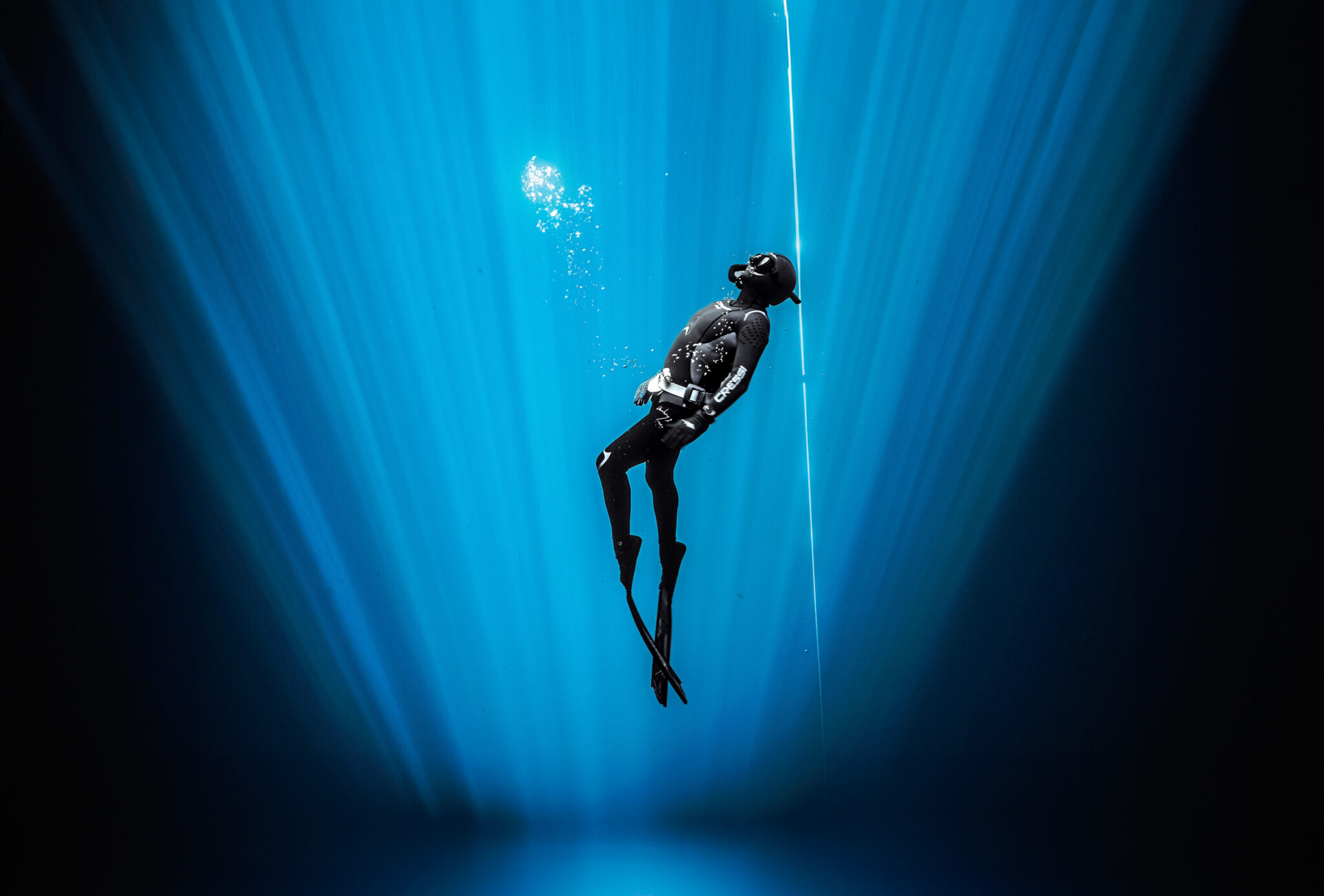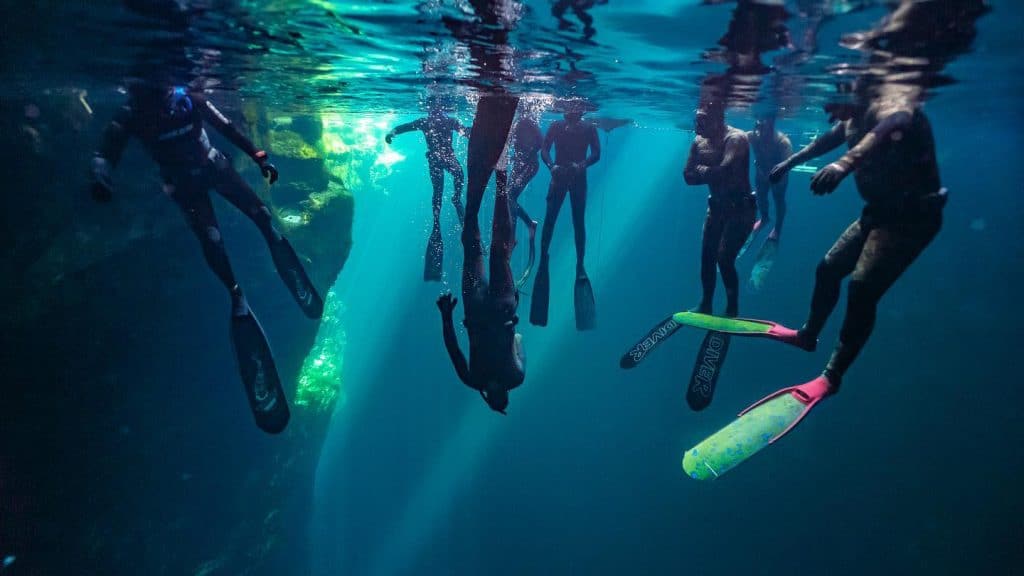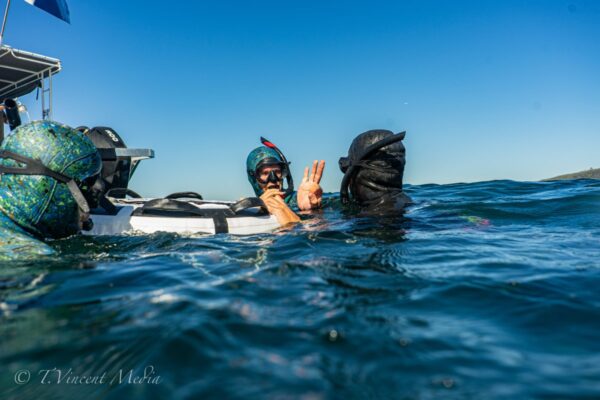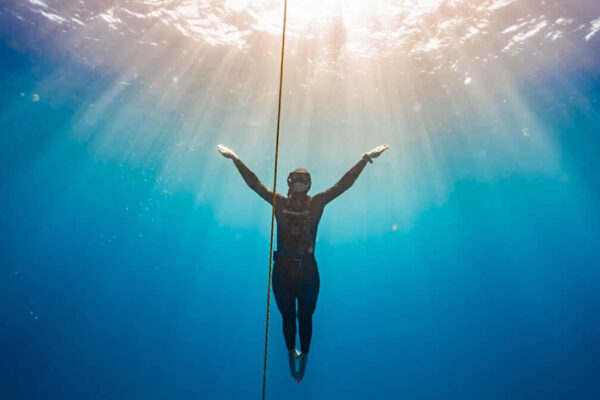
The history of freedivers reveals a journey that reaches far beyond freediving’s modern-day image as a sport or leisure activity. Once a vital survival skill, it has evolved into a discipline that blends physical endurance with mental focus. This article explores how freediving transitioned from ancient necessity to competitive sport and personal transformation.
Survival Beneath the Surface
Long before freediving was a recognized sport, it was essential for human survival. According to a blog by UW360, The first recorded evidence of freediving can be traced back more than 7,000 years to the Chinchorros, an ancient civilization that lived along the coast of the Atacama Desert. Ancient coastal communities developed breath-hold techniques to harvest food and gather underwater resources. These early divers used simple tools such as hollow reeds for breathing and turtle shells fashioned into goggles. In places like the Mediterranean, divers retrieved sponges, shellfish, and pearls, laying the foundation for techniques still used today.
Some ancient records, like Plato’s writings, mention the importance of diving in Greek society. Across Asia, female “ama” divers in Japan and Korea practiced freediving for centuries, gathering seafood in harsh underwater conditions. Their legacy continues today, reflecting the enduring human relationship with the sea.
“In one drop of water are found all the secrets of all the oceans.” – Jacques Cousteau, French naval officer and oceanographer
Cultural Significance of Freediving
Freediving held deeper meaning beyond resource gathering. In many societies, it became a cultural ritual or form of entertainment. In some parts of the world, communities developed underwater games, a precursor to modern underwater sports. Diving also found its way into folklore and legends, often symbolizing courage, resilience, and the mysterious pull of the ocean.
These early cultural practices reveal how freediving was intertwined with identity, survival, and even spirituality, long before modern gear and competitions came into the picture.
Innovations and Ingenuity
Early freedivers demonstrated remarkable ingenuity with limited resources. Stone weights helped divers descend more quickly, while natural oils were used to retain body heat. Breath control techniques were passed down through generations, and some ancient divers practiced forms of lung-packing to extend their underwater time.
This resourcefulness inspired many modern freediving pioneers, who have drawn from ancient techniques while integrating science and technology.
“Diving is a leap of faith plus gravity.” – Gabrielle Zevin, American author
From Survival to Skill
As societies evolved, freediving gradually shifted from necessity to skill. According to a blog by Free Diving Central, many cultures have relied on freediving to help feed their populations. Spearfishing and underwater exploration became more refined, leading to recreational and professional applications. The ama divers of Jeju Island, for example, eventually became part of cultural demonstrations, showcasing traditional techniques for education and tourism.
Scientific advancements in understanding gas exchange, oxygen conservation, and the effects of water pressure also made freediving safer and more accessible. With this, the foundation for a structured sport began to take shape.
The Rise of the Modern Freediver
In the 20th century, freediving saw a dramatic shift with figures like Jacques Mayol and Enzo Maiorca, who helped popularize it as a competitive and spiritual practice. Their innovations in breathing, relaxation, and equalization techniques paved the way for new disciplines within the sport.
Modern freedivers began breaking records in depth and duration. Training became more rigorous, incorporating yoga, meditation, and breath-hold exercises to develop control and resilience. These advancements helped establish freediving as a globally recognized sport.
Competitive Freediving Emerges
With the rise of formal competitions, freediving evolved into a global athletic pursuit. Organizations began regulating disciplines like constant weight (descending and ascending using fins), static apnea (holding breath while floating), and free immersion (pulling on a rope without fins). Athletes from diverse backgrounds began setting and breaking world records.
Competitions also improved safety standards, introducing depth lines, buddy systems, and strict safety protocols. These events not only test physical limits but emphasize mental clarity and focus—qualities rooted in the practice’s survivalist past.
Technology’s Role in Evolution
Modern freediving has been greatly enhanced by technology. Wetsuits made from carbon-based materials provide better insulation and flexibility. Low-volume masks offer clearer vision, and carbon fiber fins allow for more efficient movement underwater.
Advanced dive computers and monitoring equipment have made the sport significantly safer. Innovations originally developed by military divers—such as improved fin designs and safety ropes—are now standard in freediving practice.
Cultural Continuity and Modern Expression
Despite its transformation, freediving retains its cultural threads. The same breath-hold techniques once used to harvest food now help divers explore sunken shipwrecks, swim with marine life, and push personal boundaries. Instructors and recreational divers alike still draw on principles honed by ancient coastal communities.
Whether practiced for competition, personal growth, or adventure, freediving continues to reflect the human desire to explore—and embrace—the unknown beneath the surface.
Freediving’s journey from survival strategy to spiritual sport is a powerful story of human adaptability, resilience, and innovation. It blends history, biology, and culture into a discipline that demands both inner stillness and outer strength. Ready to experience this transformation for yourself? Join a course with The Pressure Project and start your freediving journey today.
FAQs
Freediving originated thousands of years ago as a survival skill used by ancient coastal communities to gather food and resources underwater. People in regions like the Mediterranean, Asia, and South America developed breath-hold diving techniques to harvest shellfish, retrieve pearls, and trade goods. Over time, these early methods evolved into both cultural practices and recreational activities.
Freediving transitioned from a means of survival to a leisure activity and competitive sport as scientific understanding of breath control, oxygen use, and underwater physiology improved. In the 20th century, pioneers like Jacques Mayol and Enzo Maiorca introduced techniques focused on mental discipline and safety, helping shape freediving into the structured sport it is today.
Early freedivers used simple tools made from natural materials. These included hollow reeds for breathing at the surface, goggles made from polished turtle shells or animal horn, and stone weights for faster descents. Natural oils were also applied to the body to reduce heat loss in cold water, while breath control techniques were passed down through generations.
Freediving held cultural and economic importance in many ancient societies. It was vital for fishing, trading, and collecting valuable underwater resources like pearls and sponges. In some cultures, it also became a spiritual or ceremonial practice, with freedivers being respected members of the community. Stories and folklore from various regions celebrated the courage and skill of these divers.
Key milestones in the history of freediving include the practices of traditional ama divers in Japan, the competitive records set by pioneers such as Jacques Mayol, and the establishment of freediving competitions by organizations like AIDA International. The development of modern equipment, safety standards, and international training programs also mark major turning points in the sport’s evolution.
Technology has greatly advanced modern freediving by improving safety, performance, and comfort. Innovations include low-volume masks for better visibility, carbon fiber fins for efficient propulsion, streamlined wetsuits for thermal protection, and dive computers for real-time tracking. These advancements allow freedivers to explore deeper depths more safely and confidently than ever before.
Influential figures in freediving history include Jacques Mayol, known for introducing the spiritual and meditative aspects of the sport; Natalia Molchanova, who dominated static and dynamic disciplines; and William Trubridge, a leader in unassisted depth records. These athletes helped push the boundaries of what the human body can achieve underwater while promoting safety and awareness.
Competitive freediving includes several disciplines, each testing different skills. These include static apnea (holding breath without movement), dynamic apnea (swimming horizontally underwater with or without fins), constant weight (descending and ascending using fins), free immersion (pulling down and up on a rope), and no-limits diving, where divers use weighted sleds for descent and inflatable bags for ascent. Each discipline has unique challenges and training methods.
Ready to dive deeper into life? Join a course with The Pressure Project and transform your mindset, breath, and body—one dive at a time.




